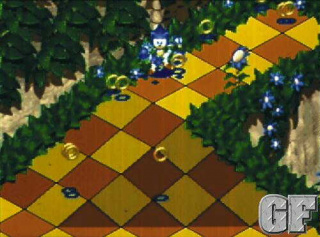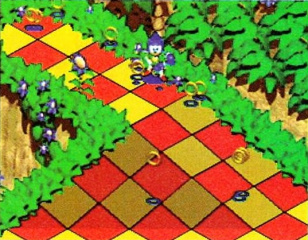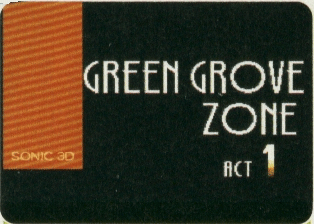Sonic 3D: Flickies' Island/Development
From Sonic Retro
- Back to: Sonic 3D: Flickies' Island.
Sonic 3D: Flickies' Island had gone through several changes over its development process. There are several rejected ideas, level designs, and other things that were left on the cutting room floor. The following details several of these things.
Contents
Development process
Mega Drive
After slow sales for the Sega Saturn in the West, Sega of America and Sega of Europe requested a new Sonic the Hedgehog game for the Mega Drive. Sega of Japan decided to outsource development to the UK-based studio Traveller's Tales, based on the strength of their Toy Story game. Traveller's Tales initially turned down Sega's offer to develop another Mega Drive game, wanting to concentrate on the PlayStation and Sega Saturn instead, until Sega revealed that the project was the next game in the Sonic series.[1]

Sonic Team's Hirokazu Yasuhara, Takashi Iizuka and Takao Miyushi were responsible for the game design and level maps, leaving the programming and art to Traveller's Tales. Head of Travellers' Tales, Jon Burton, wrote most of the code while artistic duties were headed by James Cunliffe. Development would begin in Late 1995 and in the beginning, the project was known as Sonic Spindrift, before becoming Sonic Blast by E3 1996.
A two-player split-screen was originally planned for the game, but was cancelled due to difficulties seeing what lay ahead with the isometric perspective. A prototype does exist for it however and it was shown off by the game's lead programmer Jon Burton [2]
The graphics were rendered on Silicon Graphics workstations running SoftImage.
The full-screen introduction video was kept secret from Sega, and revealed only two weeks before the game was set to be finished.
Saturn
According to developer Neil Harding, the Saturn version's 3D special stages were taken directly from early version of Sonic Jam[3] (then known under the confusing name of Sonic 3D) at the behest of Sega of Japan, who was growing upset with Jam's delays and wished to use the code elsewhere.[4]
In addition to the original Sega Mega Drive version, the game was later ported to the Sega Saturn to make up for the cancellation of Sonic X-treme. The game was ported in seven weeks, and uses the same Motorola 68000 source code of the Mega Drive version, albeit one converted into C through a special compiler created for the project. Any enhanced graphics or special effects run on top of the game and do not interact with the original source code in any way.
A minigame called Sonic Pool was considered for inclusion in the Saturn version but was scrapped in favour of a more traditional "tube" special stage.
Prototypes
Many prototypes of Sonic 3D have been found over the years. The first to be found was this 2006 cartridge prototype. Then in 2008 drx released 7 more Mega Drive protos: beta 73, beta 814, beta 819, beta 825, beta 830, beta 831, and beta 94. The 825 beta is quite similar to the 2006 cartridge prototype. At this same time a Saturn tech demo was also found.
Test plan
| |
Main article: Sonic 3D: Flickies' Island test plan |
What seems to be a checklist used when testing Sonic 3D in North America has been found.
PAL cover art
For the European cover art (also used in Australia), Sega Europe subcontracted the work to London-based design firm Me Company, best known for creating album covers with singer Björk, as well as a variety of other acts during the 1990s. Sonic's head was modelled in clay and then digitised, before being made to look like a 3D model. While the exact details are unknown, Me Company are known to have used Macintosh computers running Infini-D around this period.
This design was only ever used in PAL territories - the US and Japan opted for their own looks.
Demo tracks
At around May 1996 during development, Jun Senoue composed demo versions of some of the tracks that would be included in the Mega Drive version of Sonic 3D, and an AXIA J'z2 Type II High Position cassette tape containing these recordings, labelled "Sonic 3D Demo Takes #1", was sent to Jon Burton by Sega for review. The tracks on the tape were composed and recorded on a synthesizer, likely a KORG TR-RACK (or one of its successors) with the percussion done separately on a Roland Sound Canvas SC-55, and would be converted for play on the Mega Drive if approved.
Images of the tape were shown off on Jon's YouTube channel GameHut on October 2nd, 2017, but was initially reluctant to upload the recordings out of concerns over copyright with Sega and wished to seek permission[5]. However, due to growing concerns of losing the recordings due to outbreaks of fires in California in 2018 and 2019, Jon gradually uploaded the recordings onto YouTube.
Due to the recordings originating from a cassette tape, the tracks contain a fair amount of tape hiss, wow, and flutter. Some of these tracks were left out of the game for various reasons as described in the Notes column.
| Track | Track name | Audio | Notes |
|---|---|---|---|
| A-1 | Opening (short ver.) | The final game plays the track in the key of A♭ Major. | |
| A-2 | Opening (long ver.) | The final game plays the track in the key of A Major. | |
| A-3 | Power Up | The final game plays the track in the key of A Major. | |
| A-4 | Green Alley Zone, Act 1 | "Green Alley Zone" was an early name for Green Grove Zone. The song skips a section during the second loop at the 2:05 mark, which occurred on the original tape. The final game plays this track at the same key. | |
| A-5 | Casino Night Zone, Act 1 | "Casino Night Zone" was an early name for Spring Stadium Zone. The final game plays this track at the same key. | |
| A-6 | Boss (minor key) | Exists as an unused song in some of the prototypes, and was later dropped from the game as Jon didn't like it. Jun would later repurpose the track for Sonic the Hedgehog 4: Episode I. The prototypes play this track at the same key. | |
| B-1 | Boss (major key) | Same as above, but in a major key. | |
| B-2 | Special Stage | This track would instead be used for the introduction sequence and Panic Puppet Zone Act 1. The prototypes play this track at the same key. | |
| B-3 | Bonus Stage (Miles) | This track would be used for the Special Stage for both Tails and Knuckles. The final game plays the track in the key of B Major and at a faster tempo. | |
| B-4 | Bonus Stage (Knuckles) | This track was scrapped due to cartridge restraints. It would later be repurposed for the Pleasure Castle area in Sonic Adventure's Twinkle Park. |
Prototype screenshots
Mega Drive
The images in this section only apply to the Mega Drive version.
Initial screenshots
Sega are thought to have released three screenshots of Green Grove Zone around the time of E3 1996. All are likely mockups - they each lack a heads up display and give Sonic a circular shadow, and the hedgehog is placed in impossible situations.
The Crab badnik doesn't exist in the final game, nor should it exist, as all flickies are collected. It's also not possible to walk under a bridge in the final game.
Various
This early title card image is similar to the one found in Sonic & Knuckles.
Green Grove Zone
This looks like a playable build, however the icons in the HUD are possibly simpler placeholders.[6]
Again.[6]
The flicky portion of the HUD may be static - despite having collected five flickies, the HUD only claims Sonic has two.[6]
Three flickies following Sonic but again, only two are shown in the HUD.[6]
Saturn
The images in this section apply to the Saturn version only.
Various
Spring Stadium
1996 Trailer
A trailer [7] for the Saturn version of Sonic 3D Blast, which was made by Video Detective. This is later than the prototype we have, and seems to be around late October which would be a couple of weeks before the final build. Although the main stages themselves don't seem to have any differences from the final game aside from there being no music implemented, two incomplete special stages are shown and are quite different from the final game.
- There is no music implemented.
- The sound effects are quite different and seem like placeholders.
- Getting the chaos emerald is very different as there's no sparkle effects and you shoot up into the air as you obtain it.
- Special Stage 1's first ring requirement is 50 which was changed to 40 in the final, also during the stage there are some parts of the half pipe that are completely missing, whether it's intentionally trying to mimic the concept art is unknown.
- Special Stage 2's background seems to be at a different angle, has a final ring requirement of 80 as opposed to 110 in the final game, and it also has the blue chaos emerald.
References
- ↑ https://www.pressreader.com/uk/retro-gamer/20180712/281578061413865
- ↑ https://www.youtube.com/watch?v=qH4eZcTmVM4&t
- ↑ @assemblytutor on Twitter (Wayback Machine: 2023-09-02 08:26)
- ↑ @assemblytutor on Twitter (Wayback Machine: 2023-07-05 22:09)
- ↑ [Sonic 3D News - A demo tape that I just can't play...; video by GameHut Sonic 3D News - A demo tape that I just can't play...; video by GameHut]
- ↑ 6.0 6.1 6.2 6.3 6.4 File:CVG UK 176.pdf, page 91
- ↑ https://www.youtube.com/watch?v=CbcVIqarQv0 (Ghostarchive)
| Sonic 3D: Flickies' Island | |
|---|---|
|
Main page Manuals Development |
show;hide
Scrapped Enemies: Mega Drive:
Saturn: |









































